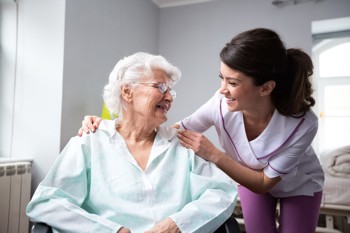
Fall risk factors
If a person has one or more of these factors, they are at risk of a fall and would benefit from a fall risk assessment:
- Previous history of a fall: This is the greatest predictor for having another fall, as the reason behind the previous fall will likely lead to future falls.
- Psychotropic medicines: These medicines, which are taken to affect behaviour, mood and perception, will also cause drowsiness, slower reactions, and reduced balance.
- Cardiovascular medicines: These medicines, which are taken to affect heart rate and blood pressure, can cause people to feel faint and unsteady on their feet.
- Combinations of medications: Polypharmacy, or taking five or more medications, can also increase falls risk.
- Psychological factors: Living alone, depression and fear of falling can lead to people not being able to focus on their environment, increasing falls risk.
- Cognitive factors: Conditions such as dementia can decrease environmental awareness and increase falls risk.
- Physical factors: Limitations in mobility, balance problems, vision impairment, reduced muscle strength, arthritis, and chronic pain can all contribute to falls risk.
- Neurological disorders: These disorders lead to difficulties with balance, mobility, strength, coordination, vision, and cognitive function, increasing falls risk.
- Intellectual disability: People with intellectual disability (ID) experience age-related changes earlier in life and suffer from falls at a younger age than the general population.
While these are the main categories of risk, more than 400 risk factors for falls have been identified.
What is a falls risk assessment
A falls risk assessment is used to determine the degree of a person’s risk of falling. It can highlight specific areas that may be contributing to this risk, such as gait, strength and/or balance. These areas can be addressed by the care provider to prevent future falls.
During the assessment
The person is tested for fall risk based on their strength, balance and gait:
- 30-Second Chair Stand Test: This measures strength and balance. The person sits in a chair with their arms crossed and asked to stand up and sit down as many times as possible in 30 seconds. The lower the number, the higher the risk for a fall.
- Timed Up-and-Go (Tug): This measures a person’s gait. The person stands up from a chair, walks 10 feet, then sits down again. If it takes them 12 seconds or more, this indicates a higher risk for a fall.
- 4-Stage Balance Test: This measures how well a person can hold their balance. The person is asked to stand in four progressively harder poses, and hold their balance for 10 seconds per pose. Failing to hold the third pose (with one foot placed directly in front of the other) for 10 seconds is an indication of increased risk for a fall.
The following additional measures should be taken:
- Identify any medications that could increase their risk of falling.
- Find out if their home has safety hazards like slippery floors or loose rugs.
- Measure blood pressure while lying and standing.
- Conduct a Snellen test to check eyesight.
- Check feet and ensure footwear is suitable.
- Measure vitamin D levels.
- Identify conditions like depression and arthritis that could increase their risk of falling.
- Carry out a cognitive test to check for their ability to remember, to be aware of surroundings, and to use judgement.
After the assessment
The assessment results will show that the person has a low, moderate, or high risk of falling. The results should indicate key areas that need to be addressed such as gait, strength or balance.
Recommendations to reduce risk of falling could include:
- Strength and balance exercises including lifting weights, using resistance bands, yoga, Pilates and tai chi.
- Changing medication dosages to reduce side effects like dizziness, drowsiness or disorientation.
- Taking vitamin D which has been associated with lower risk of falls.
- Checking eyesight to as poor eyesight affects balance, increases the risk of trips, and may cause a reluctance to undertake physical activity.
- Using safer footwear with lower heels, laces or straps, and non-slip soles.
- Consulting a podiatrist to correct any issues in balance or gait.
- Eliminating environmental hazards like poor lighting, loose rugs, or trailing cords.
- Treating medical conditions such as low blood pressure or osteoarthritis that can increase the risk of falling.
How often should a fall risk assessment be completed?
Current practice guidelines recommend a fall risk assessment at least once a year for vulnerable people.

Fall risk assessment for elderly people
Fall risk assessments for elderly people are used to identify those most at risk of falling. Having a risk assessment is a great way to start the discussion about falls prevention with older adults. Risk assessments can also be used to track progress after interventions.
Elderly fall risk assessments are important because people over 65 have the highest probability of falling, with 30% of people over 65 and 50% of people over 80 falling at least once a year. Furthermore, falls can be dangerous for the elderly, with 1 in 5 falls causing a serious injury such as broken bones or head trauma.
While many people assume that falls are an inevitable part of getting older, falls can be prevented in many cases. Care providers use fall risk assessments to identify risk factors for falling and make helpful recommendations.
Fall risk assessments benefit elderly people by:
- Minimising the risk of falling and associated injury.
- Maximising their ability to lead active lives.
- Maintaining a healthy, independent life.
Multifactorial falls risk assessment
A multifactorial falls risk assessment allows a person’s unique risk factors to be identified. These factors can then be individually targeted with appropriate interventions to prevent future falls. The assessment involves several separate components which are combined to form a single multifactorial assessment.
The multifactorial assessment is usually undertaken by a specialist falls service, but can also be carried out by a selection of healthcare professionals with appropriate skills and experience.
A multifactorial falls risk assessment can include the following:
- Detailed falls history
- Medication review
- Assessment of gait, balance and mobility
- Assessment of joint range of movement and muscle strength
- Assessment of visual acuity
- Assessment of osteoporosis risk
- Assessment of fragility fracture risk
- Assessment of continence
- Assessment of cardiovascular status
- Assessment of cognitive function
- Assessment of activities of daily living
- Assessment of fear of falling
- Assessment of foot problems and footwear
- Assessment of environmental risk factors
Following the completion of the multifactorial risk assessment a care plan can be drawn up. People with certain diagnoses will be considered as having a higher falls risk, including the following:
- People who have a history of falls
- People with a diagnosis of osteoporosis
- People with a recent hip replacement
- People with cognitive issues
- People with dementia or delirium
- People with neurological problems
- People with severe mobility issues
- People who have a fear of falling
- People with learning disabilities
- People with severe physical or mental health issues
Appropriate actions can be taken based on the assessment:
- Individualised multifactorial interventions based on the issues identified in their risk assessment.
- Appropriate clinical and environmental actions to address specific risks.
- All actions should be recorded on the person’s risk assessment document or care plan.
The multifactorial risk assessment should be reviewed:
- If the person’s condition changes
- If the person changes medication
- If the person suffers a fall or a near miss

Falls risk assessment tool
Falls risk assessment tools are used to give an objective measure of a person’s risk of falling. Depending on the tool, different characteristics of the person are examined to establish their level of risk. These characteristics include age, cognitive state, general health, comorbidities, and environment.
Common falls risk assessment tools for persons in care include:
- Falls Efficacy Scale—International (FES-I): The most used tool to evaluate fear of falling. The scale considers 16 daily life activities, and the person is asked to share their degree of concern in carrying out each activity.
- Activities-specific Balance Confidence Scale (ABC Scale): Assesses a person’s confidence in staying balanced while performing functional tasks. The person is given a questionnaire where they are asked to rate their confidence when performing 16 activities.
- Performance-Oriented Mobility Assessment (POMA): Assesses a person’s mobility with two sub-scales: a balance rating scale and a gait rating scale. The assessment takes 5-10 minutes and requires an examiner, a stopwatch, a chair, a 5 lb object, and 15 ft of walking space.
- Aachen Falls Prevention Scale: A self-assessment test to determine a person’s risk of falling. The test is quick and safe and investigates various factors that contribute to falls.
- The Fullerton Advanced Balance (FAB) Scale: A multidimensional tool to assess both static and dynamic balance. It specialises in identifying physically active seniors who are at risk of falls due to sensory impairments.
- The Balance Evaluation Systems Text (BESTest): Identifies the disordered systems underlying postural control responsible for poor functional balance in adults. It requires specific equipment and has a 20 minute administration time.
- The Downton Fall Risk Index (DFRI): Can be used to evaluate the effectiveness of muscle-strengthening programmes aimed at post-stroke rehabilitation, or to analyse populations who have previously experienced falls.
Although there are a great variety of risk assessment tools available, there is no ideal tool that can be used for any given situation. As falling risk is multidimensional, a combination of multiple tools is needed, followed by a detailed analysis by a healthcare professional.
Reducing the risk of falling
There are a range of solutions available to reduce the risk of falling and prevent falls. These include electronic sensors, wearable devices and software platforms.
At Access, we have been offering tech solutions to care providers for more than 30 years. We support over 6,000 care homes and more than 4,500 community agencies.
Our technology enabled care (TEC) solutions include:
- Home sensors identifying potential risks of falls. For example, people moving less can be a sign of inactivity, and people turning on the kettle less can be a sign of dehydration.
- Personal alarms can be worn on the person and wired to send alerts to a chosen contact, offering a virtual safety net for elderly people at risk of falls.
- Access Device Management Platform giving carers insight into the behaviours of people in their care to decrease their risk of falls.
By identifying potential causes of falls at an early stage, appropriate proactive action can be taken.
To find out about the technology enabled care (TEC) we offer at Access, contact us here to discuss your needs or to book a demo.

